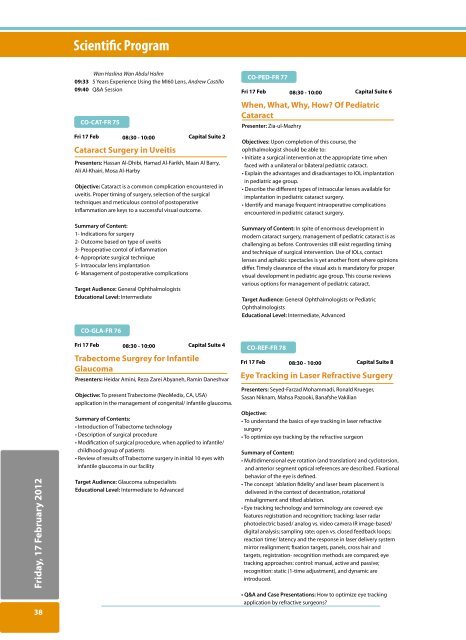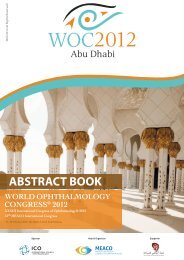You also want an ePaper? Increase the reach of your titles
YUMPU automatically turns print PDFs into web optimized ePapers that Google loves.
<strong>Scienti</strong>fic <strong>Program</strong><br />
Wan Haslina Wan Abdul Halim<br />
09:33 5 Years Experience Using the MI60 Lens, Andrew Castillo<br />
09:40 Q&A Session<br />
CO-CAT-FR 75<br />
Fri 17 Feb 08:30 - 10:00<br />
Capital Suite 2<br />
Cataract Surgery in Uveitis<br />
Presenters: Hassan Al-Dhibi, Hamad Al-Farikh, Maan Al Barry,<br />
Ali Al-Khairi, Mosa Al-Harby<br />
Objective: Cataract is a common complication encountered in<br />
uveitis. Proper timing of surgery, selection of the surgical<br />
techniques and meticulous control of postoperative<br />
inflammation are keys to a successful visual outcome.<br />
Summary of Content:<br />
1- Indications for surgery<br />
2- Outcome based on type of uveitis<br />
3- Preoperative contol of inflammation<br />
4- Appropriate surgical technique<br />
5- Intraocular lens implantation<br />
6- Management of postoperative complications<br />
Target Audience: General Ophthalmologists<br />
Educational Level: Intermediate<br />
CO-PED-FR 77<br />
Fri 17 Feb 08:30 - 10:00<br />
Capital Suite 6<br />
When, What, Why, How Of Pediatric<br />
Cataract<br />
Presenter: Zia-ul-Mazhry<br />
Objectives: Upon completion of this course, the<br />
ophthalmologist should be able to:<br />
• Initiate a surgical intervention at the appropriate time when<br />
faced with a unilateral or bilateral pediatric cataract.<br />
• Explain the advantages and disadvantages to IOL implantation<br />
in pediatric age group.<br />
• Describe the different types of intraocular lenses available for<br />
implantation in pediatric cataract surgery.<br />
• Identify and manage frequent intraoperative complications<br />
encountered in pediatric cataract surgery.<br />
Summary of Content: In spite of enormous development in<br />
modern cataract surgery, management of pediatric cataract is as<br />
challenging as before. Controversies still exist regarding timing<br />
and technique of surgical intervention. Use of IOLs, contact<br />
lenses and aphakic spectacles is yet another front where opinions<br />
differ. Timely clearance of the visual axis is mandatory for proper<br />
visual development in pediatric age group. This course reviews<br />
various options for management of pediatric cataract.<br />
Target Audience: General Ophthalmologists or Pediatric<br />
Ophthalmologists<br />
Educational Level: Intermediate, Advanced<br />
Friday, 17 February 2012<br />
38<br />
CO-GLA-FR 76<br />
Fri 17 Feb 08:30 - 10:00<br />
Capital Suite 4<br />
Trabectome Surgrey for Infantile<br />
Glaucoma<br />
Presenters: Heidar Amini, Reza Zarei Abyaneh, Ramin Daneshvar<br />
Objective: To present Trabectome (NeoMedix, CA, USA)<br />
application in the management of congenital/ infantile glaucoma.<br />
Summary of Contents:<br />
• Introduction of Trabectome technology<br />
• Description of surgical procedure<br />
• Modification of surgical procedure, when applied to infantile/<br />
childhood group of patients<br />
• Review of results of Trabectome surgery in initial 10 eyes with<br />
infantile glaucoma in our facility<br />
Target Audience: Glaucoma subspecialists<br />
Educational Level: Intermediate to Advanced<br />
CO-REF-FR 78<br />
Fri 17 Feb<br />
08:30 - 10:00<br />
Eye Tracking in Laser Refractive Surgery<br />
Presenters: Seyed-Farzad Mohammadi, Ronald Krueger,<br />
Sasan Niknam, Mahsa Pazooki, Banafshe Vakilian<br />
Capital Suite 8<br />
Objective:<br />
• To understand the basics of eye tracking in laser refractive<br />
surgery<br />
• To optimize eye tracking by the refractive surgeon<br />
Summary of Content:<br />
• Multidimensional eye rotation (and translation) and cyclotorsion,<br />
and anterior segment optical references are described. Fixational<br />
behavior of the eye is defined.<br />
• The concept ‘ablation fidelity’ and laser beam placement is<br />
delivered in the context of decentration, rotational<br />
misalignment and tilted ablation.<br />
• Eye tracking technology and terminology are covered: eye<br />
features registration and recognition; tracking: laser radar<br />
photoelectric based/ analog vs. video camera IR image-based/<br />
digital analysis; sampling rate; open vs. closed feedback loops;<br />
reaction time/ latency and the response in laser delivery system<br />
mirror realignment; fixation targets, panels, cross hair and<br />
targets, registration- recognition methods are compared; eye<br />
tracking approaches: control: manual, active and passive;<br />
recognition: static (1-time adjustment), and dynamic are<br />
introduced.<br />
• Q&A and Case Presentations: How to optimize eye tracking<br />
application by refractive surgeons






